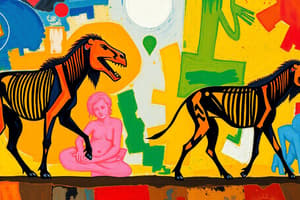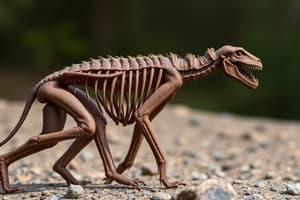Podcast
Questions and Answers
What is the main concept of Charles Darwin's theory of evolution?
What is the main concept of Charles Darwin's theory of evolution?
- Species evolve through the use and disuse of body parts
- Species evolve through the passing on of acquired traits to offspring
- Species evolve by adapting to environmental pressures through natural selection (correct)
- Species evolve through the inheritance of acquired characteristics
Which process leads to the increase in frequency of advantageous traits in a population over time?
Which process leads to the increase in frequency of advantageous traits in a population over time?
- Genetic drift
- Natural selection (correct)
- Mutation
- Gene flow
Who proposed the theory of Lamarckism, which suggests that acquired traits can be passed on to offspring?
Who proposed the theory of Lamarckism, which suggests that acquired traits can be passed on to offspring?
- Charles Darwin
- Gregor Mendel
- Jean-Baptiste Lamarck (correct)
- Alfred Russel Wallace
What is the primary mechanism driving evolutionary change according to Darwin's theory?
What is the primary mechanism driving evolutionary change according to Darwin's theory?
According to Lamarckism, how do living organisms change over time?
According to Lamarckism, how do living organisms change over time?
What is an example of evolutionary adaptation mentioned in the text?
What is an example of evolutionary adaptation mentioned in the text?
What does the fossil record provide evidence for?
What does the fossil record provide evidence for?
What does comparative embryology suggest?
What does comparative embryology suggest?
What does molecular biology indicate about different species?
What does molecular biology indicate about different species?
What does experimental evolution demonstrate?
What does experimental evolution demonstrate?
What was the major contribution of Charles Darwin to the theory of evolution?
What was the major contribution of Charles Darwin to the theory of evolution?
What concept was proposed by Jean-Baptiste Lamarck in his theory of evolution?
What concept was proposed by Jean-Baptiste Lamarck in his theory of evolution?
Which scientific evidence supports the theory of evolution as discussed in the article?
Which scientific evidence supports the theory of evolution as discussed in the article?
What does Darwin's theory of evolution emphasize as the key factor for species' survival and reproduction?
What does Darwin's theory of evolution emphasize as the key factor for species' survival and reproduction?
What type of evidence shows the gradual development of species over time, with transitional forms providing evidence for the evolutionary relationships between species?
What type of evidence shows the gradual development of species over time, with transitional forms providing evidence for the evolutionary relationships between species?
Which study reveals that certain body structures and features are shared among distantly related species, indicating a common ancestry?
Which study reveals that certain body structures and features are shared among distantly related species, indicating a common ancestry?
What does the analysis of DNA sequences from different species show, providing evidence for their common ancestry?
What does the analysis of DNA sequences from different species show, providing evidence for their common ancestry?
What does the theory of natural selection explain about the process of evolution?
What does the theory of natural selection explain about the process of evolution?
Which process describes how species evolve by making adaptations that allow them to better survive in their environment?
Which process describes how species evolve by making adaptations that allow them to better survive in their environment?
What does the study of homologous structures, such as the wings of insects and the limbs of vertebrates, reveal?
What does the study of homologous structures, such as the wings of insects and the limbs of vertebrates, reveal?
Flashcards are hidden until you start studying
Study Notes
Theory of Evolution: Charles Darwin and Lamarckism — A Comprehensive Exploration
In the fascinating field of biology, no topic captivates learners more than the theory of evolution. Charles Darwin, widely recognized as the father of modern evolutionary theory, and Jean-Baptiste Lamarck, who proposed Lamarckism, significantly shaped our understanding of how life has evolved over time. Here, we will explore Darwin's theory, natural selection, Lamarckism, and evolutionary adaptations, as well as the evidence supporting these ideas.
Darwin's Theory of Evolution
Charles Darwin, a naturalist and biologist, propounded his groundbreaking theory of evolution by natural selection in the 19th century. According to his theory, species evolve over generations by adapting to various environmental pressures, such as predation, competition, and resource availability. Through natural selection, individuals with traits that best equip them to survive and reproduce pass on their genes to the next generation, leading to evolutionary change over time.
Natural Selection
Natural selection is the process by which the most advantageous traits in a population become more common over time. For example, a species of deer with longer antlers might be more successful in attracting mates and defending against predators. Over generations, the frequency of deer with longer antlers increases, while those with shorter antlers decrease.
Lamarckism
Jean-Baptiste Lamarck, a French naturalist, proposed Lamarckism, which states that living organisms change over time by acquiring traits due to their needs and desires. According to Lamarck, when an organism uses a structure more frequently, that structure becomes larger or stronger. For instance, he believed that the giraffe's neck grows longer because it spends its life stretching to reach leaves.
Evolutionary Adaptations
Evolutionary adaptations are traits that enhance the survival and reproductive success of an organism. These adaptations can occur through genetic changes (e.g., mutations) and natural selection. For example, the peppered moth (Biston betularia) evolved darker coloration in response to the Industrial Revolution's pollution, which darkened the trees upon which the moths rested. Darker moths were better camouflaged against predators, which increased their survival and reproductive success.
Evidence of Evolution
The evidence supporting the theory of evolution is overwhelming. Some of the most compelling evidence includes:
-
Fossil records: Fossils provide a chronological record of species' evolutionary history. For example, the fossil record shows that birds evolved from dinosaurs.
-
Comparative anatomy: The similarities in anatomy between different species, such as the presence of limbs in vertebrates, indicate a shared ancestry.
-
Comparative embryology: The developmental stages of embryos of different species often reveal similarities, suggesting shared ancestry.
-
Molecular biology: The molecular similarities between different species, such as DNA sequences, indicate a shared evolutionary history.
-
Biogeography: The geographical distribution of species provides evidence for evolutionary relationships. For example, the presence of similar species on different continents suggests common ancestry.
-
Experimental evolution: Artificial selection experiments demonstrate that populations can evolve over time in response to environmental pressures.
In conclusion, the theory of evolution, as proposed by Charles Darwin and Jean-Baptiste Lamarck, has provided a framework for understanding the complex relationships between organisms and their environments. The evidence supporting the theory of evolution is robust, compelling, and has led to a deeper understanding of the natural world.
Studying That Suits You
Use AI to generate personalized quizzes and flashcards to suit your learning preferences.



